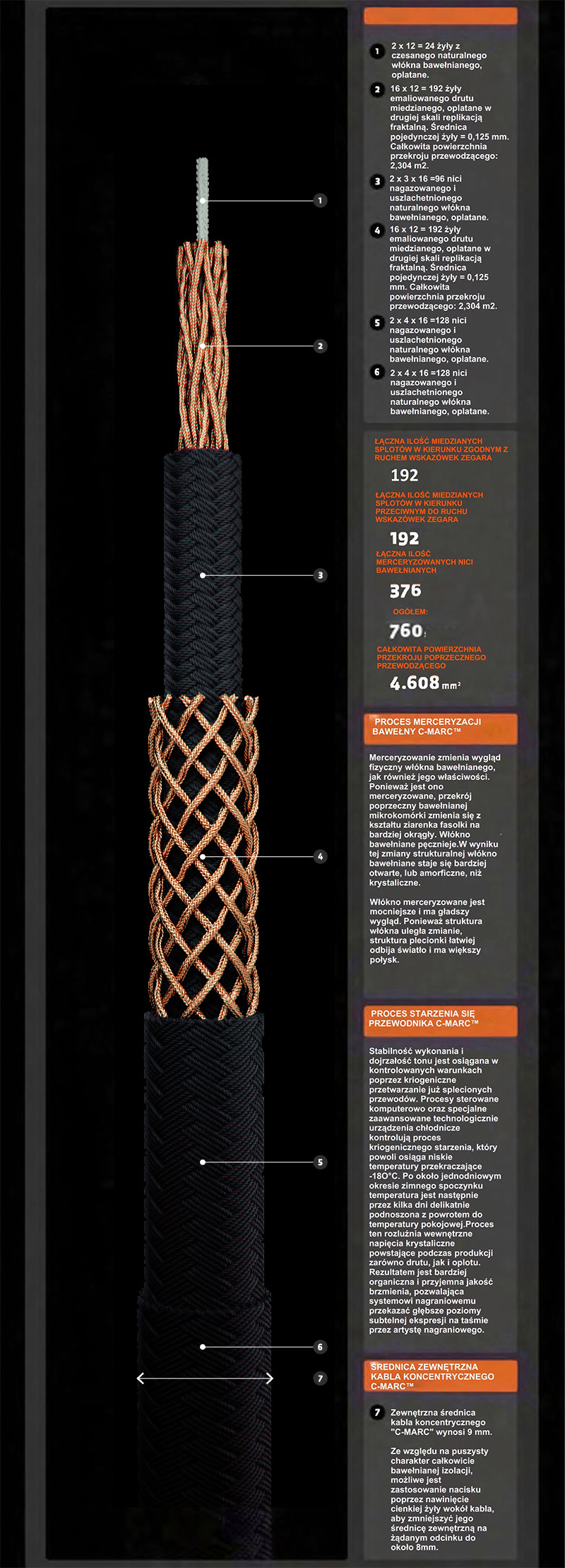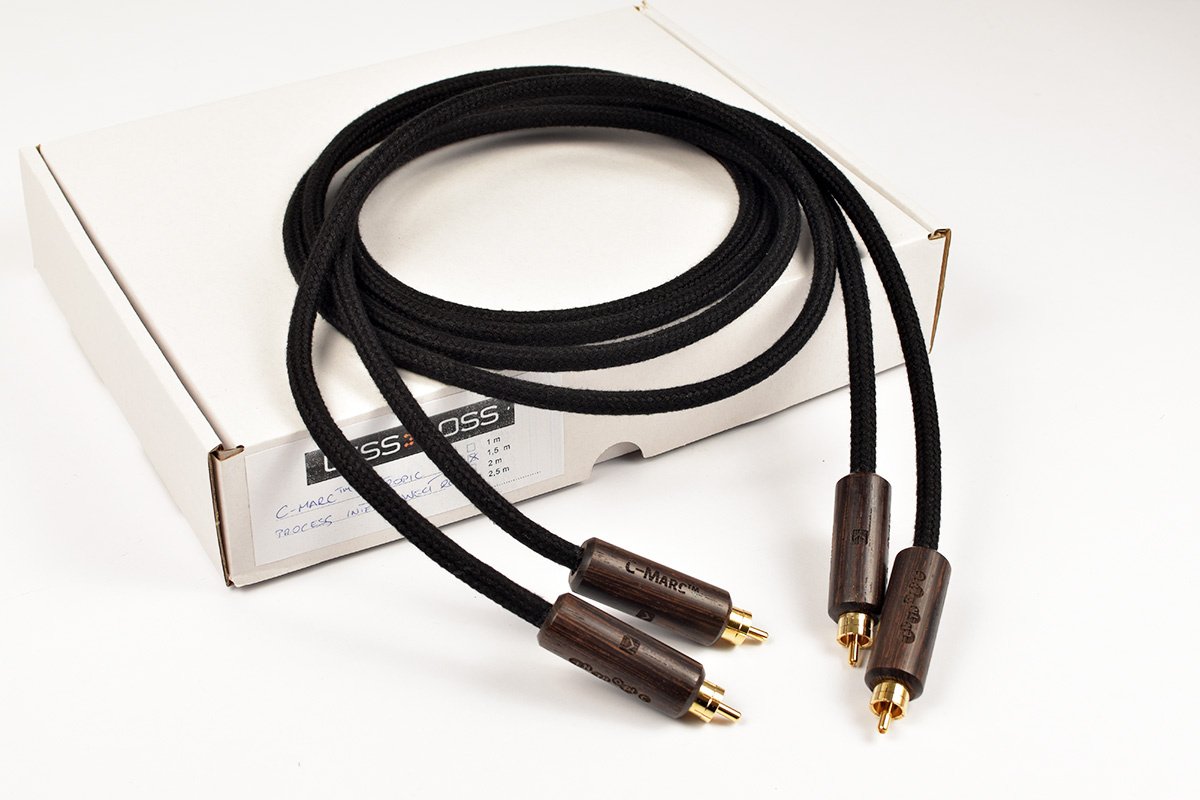LessLoss C-MARC™ Entropic Process Interconnect - RCA
- C-MARC™ to nowy rodzaj drutu typu Litz. Tłumienie hałasu C-MARC opiera się na metodzie bucking coil z wykorzystaniem dwóch przeciwspolaryzowanych cewek.
Less Loss C-MARC™ Entropic Process Interconnect - RCA
C-MARC™ to nowy rodzaj drutu typu Litz. Tłumienie hałasu C-MARC opiera się na metodzie bucking coil z wykorzystaniem dwóch przeciwspolaryzowanych cewek. Kierunek na każdym splocie dopasowuje się do odpowiadającego mu obrotu w kierunku przeciwnym do ruchu wskazówek zegara o dokładnie lustrzanej średnicy i stopniu. Powstałe w ten sposób dwie cewki o przeciwnej polaryzacji nakładają się na siebie. Następnie powtarzana jest replikacja fraktalna w drugiej skali już przerzynających się cewek. Poprzez elektryczną eliminację indukowanego szumu, C-MARC™ zapewnia ogromny stosunek sygnału do szumu w dzisiejszym wymagającym środowisku.
C-MARC™ to skrót od Common-mode Auto-rejecting Cable.
C-MARC™ jest inny niż jakikolwiek produkowany obecnie drut typu hookup lub kabel. Opiera się na metodzie bucking coil, polegającej na redukcji szumów, najbardziej znanej w konstrukcjach typu przetworników ‘twin coil’, opracowanych po raz pierwszy w połowie lat 30-tych XX wieku, w celu wyciszenia szumu z gitar elektrycznych.
Ten typ przetwornika gitarowego został nazwany Humbuckerem, ponieważ " wydobywa brzęk", czyli szum, z pożądanego sygnału gitarowego poprzez rezygnację fazową dwóch przeciwspolaryzowanych induktorów. Kiedy oba induktory wzbudzają wspólny sygnał, jest on indukowany w przeciwnych polaryzacjach przez każdą cewkę. Owe przeciwstawne polaryzacje są następnie nawzajem kasowane, kiedy dwa przeciw-polaryzujące się prądy szumowe są połączone poprzez zwykłe sumowanie elektryczne. Cewki przetwornika typu Humbucker są również stosowane w niektórych konstrukcjach mikrofonów, jak również w czułej technologii sensorów, gdzie indukowany błądzący szum jest niedopuszczalny i pożądany jest najwyższy stosunek sygnału do szumu.
LessLoss projektuje nowy rodzaj drutu na bazie zasady Humbucking
Drut C-MARC™ jest specjalnym rodzajem drutu Litz. Charakteryzuje się on wszystkimi znanymi zaletami tradycyjnego drutu typu Litz bez wady formowania go jako wydłużonej cewki (induktora).
Tradycyjny drut Litz ma nastepujące zalety w porównaniu ze zwykłym "nagim" drutem wielodrutowym i litym drutem rdzeniowym:
- Drut Litz ma większy stosunek powierzchni do przekroju poprzecznego, co powoduje mniejsze rozmycie fazowe pomiędzy niższymi i wyższymi częstotliwościami.
- Drut litzowy nie powoduje zniekształceń spowodowanych tzw. "skokami żył" lub efektami diodowymi wynikającymi z luźno stykających się warstw tlenków sąsiednich nieosłoniętych żył.
- Drut litzowy jest bardziej elastyczny, praktyczny i bezpieczniejszy od litego drutu rdzeniowego o tym samym dużym przekroju poprzecznym.
Drut C-MARC™ posiada wszystkie powyższe zalety tradycyjnego drutu typu Litz i rozwija sztukę dzięki tym dodatkowym i unikalnym zaletom:
(1) Tradycyjny drut Litz jest wiązany, a następnie skręcany tylko w jednym kierunku, co prowadzi do powstania wydłużonej grupy jednokierunkowych cewek (induktorów) o różnych średnicach, o strukturze przypominającej wydłużone, nadmiernie rozciągnięte sprężyny o różnych rozmiarach.
[rys. 1. (w toku): Szkic typowej konstrukcji drutu typu Litz, w którym średnice zwojów i kierunek obrotu pojedynczego zwoju przypomina kilka spiętych ze sobą sprężyn o zbyt dużym naciągu. Konstrukcja ta pozwala na dużą prędkość produkcji].
[rys. 2. (w toku): Każdy długi, osobno izolowany drut Litz może być przedstawiony jako osobna cewka o danej średnicy i stopniu. Różne średnice są wynikiem wiązania przed wzajemnym skręceniem].
[rys. 3. (w toku): Poszczególne druty o różnych grubościach są wiązane razem, tworząc różne geometrie. Istnieje wiele wariantów struktury Litza, w większości opartych na głównej idei najpierw wiązania, a następnie skręcania w spirale].
Drut Litz “Typu 7"
[rys. 4. (w toku): Niektórzy producenci oferują plecionkę z drutu typu Litz. Drut ten jest również formowany z początkowo wiązanych i nawzajem skręcanych splotów przed zaplataniem. Ten rodzaj drutu jest często nazywany drutem litowym typu 7 i jest ściskany po oplataniu skręconych wiązek w ogólny prostokątny kształt przed owinięciem taśmy i nadmiernym wytłoczeniem].
Co wyróżnia C-MARC™ od innych?
Dla kontrastu, drut C-MARC™ w całkowicie lustrzanej, zbalansowanej geometrii sprowadza się do bardzo zasadniczych czynników. Wyrównuje on każdą żyłę drutu Litz w kierunku zgodnym z ruchem wskazówek zegara z odpowiadającym jej obrotem w kierunku przeciwnym do ruchu wskazówek zegara o dokładnie lustrzanej średnicy i stopniu na całej długości drutu. Te dwie wynikowe spirale nakładają się na siebie w sposób przeciwstawny. Hałas indukowany jest więc w dokładnie przeciwstawnych polaryzacjach i w dokładnie odzwierciedlonych amplitudach, podczas gdy dobry sygnał jest wspólny dla obu spiral. Dwa przeciwspolaryzowane sygnały szumu znoszą się nawzajem w momencie, gdy przeciwspolaryzowane prądy łączą się poprzez prosty kontakt elektryczny na obu końcach spirali. W ten sposób, dzięki samoczynnemu odrzucaniu przeciwstawnej fazy elektrycznej poprzez sumowanie na końcach przewodu, przewód C-MARC™ doskonale przeciwdziała indukcji szumu, czy to ze źródeł zewnętrznych, czy też samoczynnie indukowanego, który normalnie zanieczyszcza każdy inny skręcony zespół przewodów Litz. W ten sposób, drut C-MARC™ osiąga transfer sygnału, który jest uszkodzony w znacznie mniejszym stopniu niż przemysł jest w stanie osiągnąć za pomocą innych środków.
[rys. 5. (w toku): C-MARC™ Schematyczny układ drutu typu Litz. Spirale zgodne z ruchem wskazówek zegara i przeciwne do ruchu wskazówek zegara posiadają lustrzane odbicie średnicy, stopnia i grubości drutu, a jednocześnie są ułożone względem siebie. Powoduje to odwrotną indukcję fazową w obrębie samej struktury pojedynczej linii polaryzacji. Podczas gdy prędkość produkcji jest znacznie wolniejsza, cisza pracy drutu C-MARC™ znacznie przewyższa standardowe struktury drutu typu Litz].
(2) To jeszcze nie wszystko. Drut LessLoss C-MARC™ charakteryzuje się dwuskalową, "fraktalną" replikacją wyżej wymienionego, wzajemnie nakładającego się, przeciwbieżnego układu. Ta lustrzana i zagnieżdżona struktura dodatkowo wzmacnia wzajemną rezygnację z przeciwspolaryzowanych skrętów indukcyjnych, pozwalając jednocześnie na powiększenie przekroju poprzecznego kabla, który służy do dalszego obniżenia oporności bez utraty wierności i elastyczności sygnału. 
[rys. 6.: C-MARC™ pokazany w dwuskalowej replikacji fraktalnej. Wszystko, co jest pokazane geometrycznie na poziomie rdzenia, jest powtarzane na większym poziomie, co jeszcze bardziej redukuje indukcję hałasu. Tak jak początkowe spirale zgodne z ruchem wskazówek zegara i przeciwne do ruchu wskazówek zegara są odzwierciedlone w średnicy, stopniu i mierniku drutu, a jednocześnie są nałożone względem siebie, tak i na większym poziomie.Sprawia to, że kabel jest bardzo cichym elementem, nie wpływając jednocześnie na naturalną barwę tonów wrażliwych sygnałów w całym spektrum częstotliwości].
Co to oznacza?
C-MARC™ jest najcichszym drutem istniejącym na planecie i zapewnia czystą transmisję sygnału. Stopień ciszy rozwiązania roboczego jest wprost proporcjonalny do stopnia nakładania się na siebie skrętów przeciwspolaryzowanych, jak również do stopnia ich lustrzanego zrównania pod względem promienia skrętu, stopnia i oporu. Idea polega na tym, że obie przeciwstawne "polaryzacje" pojedynczego drutu C-MARC™ wywołują dokładnie ten sam szum, a idealne zsumowanie do zera da rezultat na obu końcach linii.
(3) Ponieważ poszczególne emaliowane druty, które składają się na unikalną strukturę drutu Litz C-MARC™ mają bardzo małą średnicę (0,125 mm), zwiększa to stosunek pomiędzy całkowitą powierzchnią a całkowitym przekrojem poprzecznym dla jeszcze lepszej relacji fazowej w całym spektrum.
(4) Taka konstrukcja dodatkowo zwiększa elastyczność i łatwość układania na dowolnej osi, szczególnie w przypadku kabli o dużym przekroju, bez niepotrzebnego powiększania całego zespołu kabli..
(5) Skrętki stosowane w drutach C-MARC™ pokryte są najcieńszą możliwą technicznie bezbarwną emalią. Są one lutowalne po ocynowaniu w garnku lutowniczym.
(6) Nie zastosowano żadnego tworzywa sztucznego; zamiast tego drut i kable C-MARC™ są szczelnie izolowane oplotem ze 100% naturalnego, gazowanego i zmacerowanego włókna bawełnianego z podwójnym pokryciem zapewniającym dodatkową ochronę. W rezultacie otrzymujemy bardzo lekki, bardzo elastyczny, naturalnie brzmiący produkt o najlepszych obecnie właściwościach użytkowych, przeznaczony do delikatnych zastosowań audio, o ogromnym stosunku sygnału do szumu.
Jak nowy kabel C-MARC™ RCA wypada w porównaniu z Anchorwave i Homage to Time?
Tonalny charakter produktów C-MARC™ jest bardziej płynny i eliminuje więcej szczegółów z każdego nagrania. Tak dobry jak Homage to Time, jest on wykonany z tworzywa sztucznego (aczkolwiek bardzo wysokiej jakości tworzywa sztucznego o doskonałej charakterystyce). Poza tym, że C-MARC™ jest wykonany w całości z bawełny i bardzo cienkiej warstwy lakieru bezbarwnego zamiast z tworzywa sztucznego, wyjątkowo dobrze zrównoważona technika cewki z przeciwbieżnymi polaryzacjami obniża poziom szumu jeszcze bardziej niż metody stosowane w Anchorwave i Homage to Time, więc ostateczny rezultat to zarówno obniżony poziom szumu, jak i czysty charakter tonalny. Bardzo łatwo jest rozpoznać tę poprawę od samego początku, nawet bez efektu wypalenia.
Po około 14 dniach ustabilizowania się, jakość dźwięku staje się jeszcze bardziej organiczna i naturalna.
Kolejną zaletą C-MARC™ w stosunku do Anchorwave i Homage to Time jest jego niezwykła elastyczność i niewielka waga.














